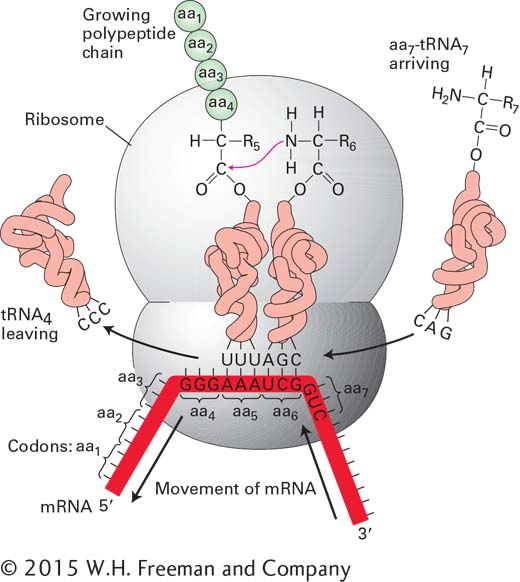5.3 The Decoding of mRNA by tRNAs
Although DNA stores the information for protein synthesis and mRNA conveys the instructions encoded in DNA, most biological activities are carried out by proteins. As we saw in Chapter 3, the linear order of amino acids in each protein determines its three-
Translation is the whole process by which the nucleotide sequence of an mRNA is used as a template to join the amino acids of a polypeptide chain in the correct order (see Figure 5-1, step 3). In eukaryotic cells, protein synthesis occurs in the cytoplasm, where three types of RNA molecules come together to perform different but cooperative functions (Figure 5-17):

Messenger RNA (mRNA) carries the genetic information transcribed from DNA in a linear form. The mRNA is read in sets of three-
nucleotide sequences, called codons, each of which specifies a particular amino acid. Transfer RNA (tRNA) is the key to deciphering the codons in mRNA. Each type of amino acid has its own subset of tRNAs, which are covalently bound to that amino acid and carry it to the growing end of a polypeptide chain when the next codon in the mRNA calls for it. The correct tRNA with its attached amino acid is selected at each step because each specific tRNA molecule contains a three-
nucleotide sequence, an anticodon, that can base- pair with its complementary codon in the mRNA. Ribosomal RNA (rRNA) associates with a set of proteins to form ribosomes. These complex structures, which physically move along an mRNA molecule, catalyze the assembly of amino acids into polypeptide chains. They also bind tRNAs and various accessory proteins necessary for protein synthesis. Ribosomes are composed of a large and a small subunit, each of which contains its own rRNA molecule or molecules.
These three types of RNA participate in the synthesis of proteins in all organisms. In this section, we focus on the decoding of mRNA by tRNAs and how the structure of each of these RNAs relates to its specific task. How they work together with ribosomes and protein factors to synthesize proteins is detailed in the following section. Because translation is essential for protein synthesis, the two processes are commonly referred to interchangeably. However, the polypeptide chains resulting from translation must undergo post-